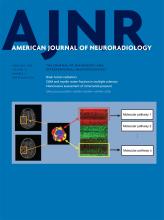Index by author
Schindera, S.
- Spine Imaging and Spine Image-Guided InterventionsYou have accessSystematic Radiation Dose Reduction in Cervical Spine CT of Human Cadaveric Specimens: How Low Can We Go?M. Tozakidou, C. Reisinger, D. Harder, J. Lieb, Z. Szucs-Farkas, M. Müller-Gerbl, U. Studler, S. Schindera and A. HirschmannAmerican Journal of Neuroradiology February 2018, 39 (2) 385-391; DOI: https://doi.org/10.3174/ajnr.A5490
Schmitt, B.
- Adult BrainOpen AccessAddition of Amide Proton Transfer Imaging to FDG-PET/CT Improves Diagnostic Accuracy in Glioma Grading: A Preliminary Study Using the Continuous Net Reclassification AnalysisA. Sakata, T. Okada, Y. Yamamoto, Y. Fushimi, T. Dodo, Y. Arakawa, Y. Mineharu, B. Schmitt, S. Miyamoto and K. TogashiAmerican Journal of Neuroradiology February 2018, 39 (2) 265-272; DOI: https://doi.org/10.3174/ajnr.A5503
Schubert, G.A.
- FELLOWS' JOURNAL CLUBSpine Imaging and Spine Image-Guided InterventionsYou have accessClinical and Radiologic Characteristics of Deep Lumbosacral Dural Arteriovenous FistulasF. Jablawi, O. Nikoubashman, G.A. Schubert, M. Dafotakis, F.-J. Hans and M. MullAmerican Journal of Neuroradiology February 2018, 39 (2) 392-398; DOI: https://doi.org/10.3174/ajnr.A5497
Twenty patients with deep lumbosacral spinal dural arteriovenous fistulas were included in this series. Cord T2 hyperintensity and contrast enhancement were present in most cases. The filum vein and/or lumbar veins were dilated in 95% of patients. Time-resolved contrast-enhanced dynamic MRA indicated a spinal DAVF at or below the L5 vertebral level in 7/8 (88%) patients who received time-resolved contrast-enhanced dynamic MRA before DSA. A bilateral arterial supply of the fistula was detected via DSA in 5 (25%) patients. The authors conclude that time-resolved contrast-enhanced dynamic MRA facilitates the detection of the drainage vein and helps to localize deep lumbosacral-located fistulas with a high sensitivity before DSA. Definite detection remains challenging and requires conventional spinal angiography.
Scott, J.
- Adult BrainOpen AccessRadiomics in Brain Tumor: Image Assessment, Quantitative Feature Descriptors, and Machine-Learning ApproachesM. Zhou, J. Scott, B. Chaudhury, L. Hall, D. Goldgof, K.W. Yeom, M. Iv, Y. Ou, J. Kalpathy-Cramer, S. Napel, R. Gillies, O. Gevaert and R. GatenbyAmerican Journal of Neuroradiology February 2018, 39 (2) 208-216; DOI: https://doi.org/10.3174/ajnr.A5391
Sebaaly, M.G.
- Pediatric NeuroimagingYou have accessOptic Nerve Measurement on MRI in the Pediatric Population: Normative Values and CorrelationsC.E. Al-Haddad, M.G. Sebaaly, R.N. Tutunji, C.J. Mehanna, S.R. Saaybi, A.M. Khamis and R.G. HouraniAmerican Journal of Neuroradiology February 2018, 39 (2) 369-374; DOI: https://doi.org/10.3174/ajnr.A5456
Sennoga, C.A.
- NeurointerventionYou have accessThe Role of Hemodynamics in Intracranial Bifurcation Arteries after Aneurysm Treatment with Flow-Diverter StentsA.P. Narata, F.S. de Moura, I. Larrabide, C.M. Perrault, F. Patat, R. Bibi, S. Velasco, A.-C. Januel, C. Cognard, R. Chapot, A. Bouakaz, C.A. Sennoga and A. MarzoAmerican Journal of Neuroradiology February 2018, 39 (2) 323-330; DOI: https://doi.org/10.3174/ajnr.A5471
Silbergleit, R.
- Adult BrainYou have accessDural Arteriovenous Fistulas: A Characteristic Pattern of Edema and Enhancement of the Medulla on MRIA.Z. Copelan, A. Krishnan, H. Marin and R. SilbergleitAmerican Journal of Neuroradiology February 2018, 39 (2) 238-244; DOI: https://doi.org/10.3174/ajnr.A5460
Silva, D.
- EDITOR'S CHOICEAdult BrainOpen AccessFeasibility of Brain Atrophy Measurement in Clinical Routine without Prior Standardization of the MRI Protocol: Results from MS-MRIUS, a Longitudinal Observational, Multicenter Real-World Outcome Study in Patients with Relapsing-Remitting MSR. Zivadinov, N. Bergsland, J.R. Korn, M.G. Dwyer, N. Khan, J. Medin, J.C. Price, B. Weinstock-Guttman and D. Silva on behalf of the MS-MRIUS Study GroupAmerican Journal of Neuroradiology February 2018, 39 (2) 289-295; DOI: https://doi.org/10.3174/ajnr.A5442
Brain atrophy outcomes of 590 patients were analyzed by the percentage brain volume change measured by structural image evaluation with normalization of atrophy on 2D-T1WI and 3D-T1WI and the percentage lateral ventricle volume change, measured by VIENA on 2D-T1WI and 3D-T1WI and NeuroSTREAM on T2-FLAIR examinations. The median annualized percentage brain volume change was -0.31% on 2D-T1WI and -0.38% on 3D-T1WI. The median annualized percentage lateral ventricle volume change was 0.95% on 2D-T1WI, 1.47% on 3D-T1WI, and 0.90% on T2-FLAIR. The authors conclude that brain atrophy was more readily assessed by estimating the percentage lateral ventricle volume change on T2-FLAIR compared with the percentage brain volume change or percentage lateral ventricle volume change using 2D- or 3D-T1WI.
Silver, B.
- Adult BrainOpen AccessLeukoaraiosis Attenuates Diagnostic Accuracy of Large-Vessel Occlusion ScalesY. Mayasi, R.P. Goddeau, M. Moonis, B. Silver, A.H. Jun-O'Connell, A.S. Puri and N. HenningerAmerican Journal of Neuroradiology February 2018, 39 (2) 317-322; DOI: https://doi.org/10.3174/ajnr.A5473
Sinclair, J.
- Adult BrainYou have accessDiagnostic Accuracy of Centrally Restricted Diffusion in the Differentiation of Treatment-Related Necrosis from Tumor Recurrence in High-Grade GliomasN. Zakhari, M.S. Taccone, C. Torres, S. Chakraborty, J. Sinclair, J. Woulfe, G.H. Jansen and T.B. NguyenAmerican Journal of Neuroradiology February 2018, 39 (2) 260-264; DOI: https://doi.org/10.3174/ajnr.A5485








